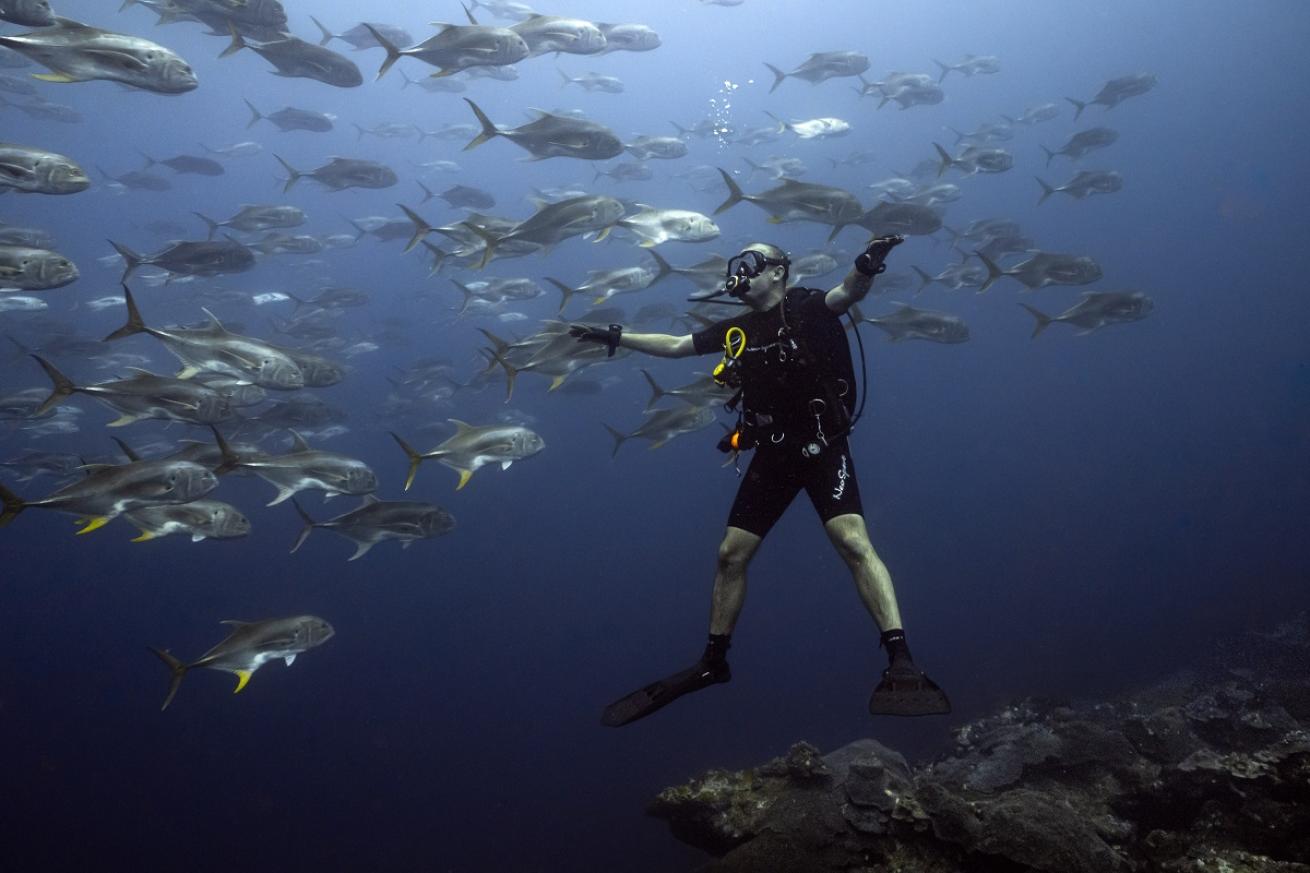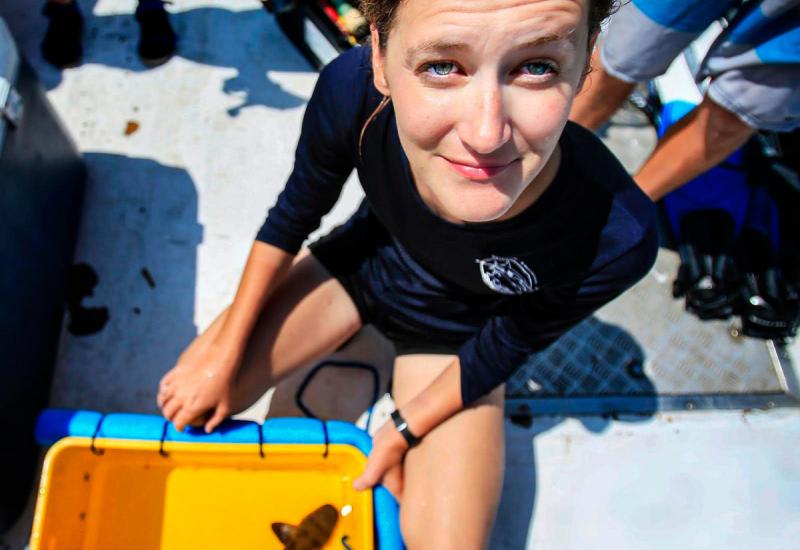How to Dive Flower Garden Banks National Marine Sanctuary

Scott Bauer/Get Into Your Sanctuary Photo ContestA diver surrounded by a school of amberjacks.
Flower Garden Banks National Marine Sanctuary is an off-the-beaten-path destination for the most adventurous divers. Here's what you need to know about diving this sanctuary.
Quick Facts:
Flower Garden Banks National Marine Sanctuary is made up of 17 different reefs and banks located about 70-115 miles off the Texas-Louisiana coast. These protected areas are a true treasure of the Gulf of Mexico—a Caribbean oasis in an unexpected place. Each year, 2,500-3,000 divers visit the sanctuary to explore some of the healthiest coral in the world.
The three banks of the national marine sanctuary each have several moored dive sites, with typical dive profiles of 70-130 feet. East Flower Garden Bank, West Flower Garden Bank and Stetson Bank are actually small underwater mountains created by salt domes. The tops of these banks are covered in gardens of coral, sponges and algae that provide habitats for a variety of tropical wildlife. Visitors to Flower Garden Banks can explore coral heads the size of cars, schools of fish, graceful spotted eagle and manta rays, and may even have a chance to witness majestic whale sharks during summer visits to the area.
Dive Profiles:
Dive depths generally range from 70-90 feet. Nitrox is a good choice for offsetting some of the extra nitrogen loading that can occur on the deep, flat profiles. On two-day liveaboard trips, operators offer four dives during daylight hours plus one night dive on the first day followed by two morning dives on the second. As a safety measure, divers are also limited to a maximum depth of 130 feet on the first dive of the day and 100 feet on all subsequent dives. All surface intervals—without exception—are two-and-a-half hours minimum. Liveaboard crews caution divers to make slow ascents, a one-minute safety stop at half their maximum depth and a three- to five-minute stop at 15 feet.
Recommended Training:
Since currents and weather can be unpredictable this far out in the Gulf, this dive adventure is best suited for advanced divers. While conditions can be calm and suitable for beginners, those occasions are extremely rare. More typically, you will experience multiple currents, running in different directions and speeds at different depths. Currents may develop or disappear in the middle of your dive. Or, they may change direction or speed, requiring you to swim against a current to return to your exit point. Wave height and frequency are also quite variable and can make it difficult to board the boat safely. Previous experience diving in waters with current and using a surface marker buoy is strongly recommended before diving this offshore sanctuary.
WATCH: Earth Is Blue: Flower Garden Banks National Marine Sanctuary

Steve Miller/Get Into Your Sanctuary Photo ContestA spotted moray eel at Flower Garden Banks National Marine Sanctuary.
When to Go:
Flower Garden Banks National Marine Sanctuary has two dive seasons. The summer season is from May through October, and winter diving runs from February through April. Surface water temperatures range from the low- to mid-80s in the summer months to the low- to high-60s in the winter. Visibility varies from a crystal clear 75-125 feet in the summer to 30-75 feet in the winter months.
January through March: Spotted eagle rays are known to school in and around Flower Garden Banks National Marine Sanctuary during the early part of the year. During this time, it's also not unusual to see large schools of male scalloped hammerhead sharks. Scientists don’t truly know the reason for this seasonal schooling, but have noted that it’s a regular occurrence in this part of the Gulf of Mexico.
July through September: Whale sharks are summer visitors to Flower Garden Banks, migrating through the sanctuary during the summer months. The reason for their visits is yet to be determined, but divers enjoy the occasional encounters.
August: For about 7-10 days after the full moon in August, usually between 9 p.m. and midnight, several coral species at the Flower Garden Banks sanctuary participate in a mass spawning event. At this time, coral heads release their gametes into the water column where they can mix and fertilize, later becoming larvae that settle to the bottom and start new coral colonies. It’s like an underwater snowstorm, in reverse!

G.P. Schmahl/NOAAFlower Garden Banks National Marine Sanctuary has some of the healthiest corals in the world.
Where to Dive:
Stetson Bank: Stetson Bank is situated about 80 miles from the shore, and the site here looks like an out-of-this-world moonscape. Beyond the open sand flats, you see low-level outcroppings dominated by parallel rocky ridges. These are the eroded edges of rock layers resulting from salt dome formation. At Stetson Bank, there is less coral cover, so the ridges are right out in the open. Hiding between the ridges you might find sea urchins, moray eels, sponges or even an octopus or two. Countless ridges are also covered in an encrusting form of fire coral. Many divers consider Sierra Madracis, the largest coral formation in Stetson Bank, to be the best diving spot in the area. This pinnacle is often frequented by schools of creolefish.
East and West Flower Garden Banks: At these two sites, there is so much coral that you can hardly believe your eyes. Boulders of coral pile on top of one another, creating an amazing seascape. As much as 52% of the bottom is covered in live coral. Fish like bluehead and yellowhead wrasses, schools of chromis and creolefish, butterflyfish, parrotfish, groupers and a variety of damselfish often frequent the bank. Christmas tree worms live right in the middle of coral heads with their bodies burrowed into the coral skeleton and only their colorful gills showing. In the open sand channels of East and West Flower Garden Banks, you may find an occasional nurse shark, sea turtle or stingray resting. Queen conchs can be found throughout these areas too. Don’t forget to look up every once in a while or you might miss a passing manta ray, spotted eagle ray or shark.

Jesse CancelmoWhale shark sightings are possible in Flower Garden Banks National Marine Sanctuary during July, August, and September when surface conditions are calmer.
Other Sites: On January 19, 2021, Flower Garden Banks National Marine Sanctuary expanded from 56 square miles to 160 square miles to protect additional critical habitats in the Gulf of Mexico. The sanctuary is currently working on adding mooring buoys at other dive sites in the expanded areas. Other banks that are within recreational dive limits are Sonnier, Bright and Geyer Banks.
What to See:
Flower Garden Banks is home to hundreds of species of marine life, including sea turtles, incredible echinoderms (sea stars, sea urchins, sea cucumbers), jellies, crabs, shrimp, dolphins, sharks and some of the healthiest corals in the world. Smaller fish species include damselfish, cowfish, filefish, jacks, spotted moray eel, balloonfish, queen and french angelfish, scorpionfish and golden smooth trunkfish.
It’s also an especially great place for spotting manta rays and has been identified by scientific researchers to be a nursery habitat for the animal. Manta rays can grow to be enormous at Flower Garden Banks, with some reaching 22 feet from fin-tip to fin-tip. This is compared to those found in other parts of the northwestern Gulf of Mexico, where they tend to have a 14-foot wingspan at most, with many measuring less than six feet. While there is no special time of the year to expect manta rays, it’s an awesome experience to see one gliding over the reef, swooping and turning to capture plankton in its large open mouth.
NOAA’s Office of National Marine Sanctuaries asks that all divers follow their Wildlife Viewing Guidelines while enjoying these underwater treasures. A species list for Flower Garden Banks National Marine Sanctuary can be found here.
Dive Charters:
The sanctuary is offshore and only accessible by boat, so divers interested in visiting these hidden gems should book through daily dive charters or multi-day liveaboards for a truly unique Gulf of Mexico experience. Charters depart from numerous Texas ports, including Galveston, Freeport, Sabine Pass and Surfside. There is no entrance fee for Flower Garden Banks National Marine Sanctuary.
This is a listing of known dive charters that visit the sanctuary. If you wish to book a trip, please contact the charter operators directly for details about their booking procedures.
Other Attractions:
- The Brazoria Wildlife Refuge, managed by the U.S. Fish and Wildlife Service, is close by and open 365 days per year. No entrance fee is required. Enjoy wildlife-related activities, including wildlife watching, hiking, hunting, fishing, and wildlife photography.
- Nearby Galveston, Texas is a classic island beach town with the historic Pleasure Pier, Moody Gardens and Galveston Island State Park. Galveston also has a 70-block historic downtown full of shops, museums, galleries and theaters.
- Houston, America’s 4th largest city, is a great getaway for any space geek, museum lover or simply anyone who wants to explore a diverse city.
- New Orleans in Louisiana is famous for its Creole and Cajun cuisine, jazz music, history and architecture.
How You Can Help
- Participate in the annual Lionfish Invitational. Trained volunteer divers, citizen scientists and research partners from across the country conduct fish surveys and remove invasive lionfish from these areas. During a two-day research and removal cruise from June 12-13, 2023, the team removed 93 lionfish and tagged 6 live lionfish for acoustic tracking at Flower Garden Banks National Marine Sanctuary.
- Help raise awareness by entering your scuba pics from this sanctuary into the annual Get Into Your Sanctuary Photo Contest! Winning photos receive special recognition, and all submitted photos are used for educational and outreach purposes to raise awareness of these special places in America’s waters.
- Report your findings! Please tell us about your visit and any interesting observations you might have made. Sanctuary staff and researchers can't be on site as much as they'd like, so we really appreciate reports from recreational divers like you. Instructions for how to send in your report can be found on this page.
For more information about the sanctuary, visit https://flowergarden.noaa.gov/.










